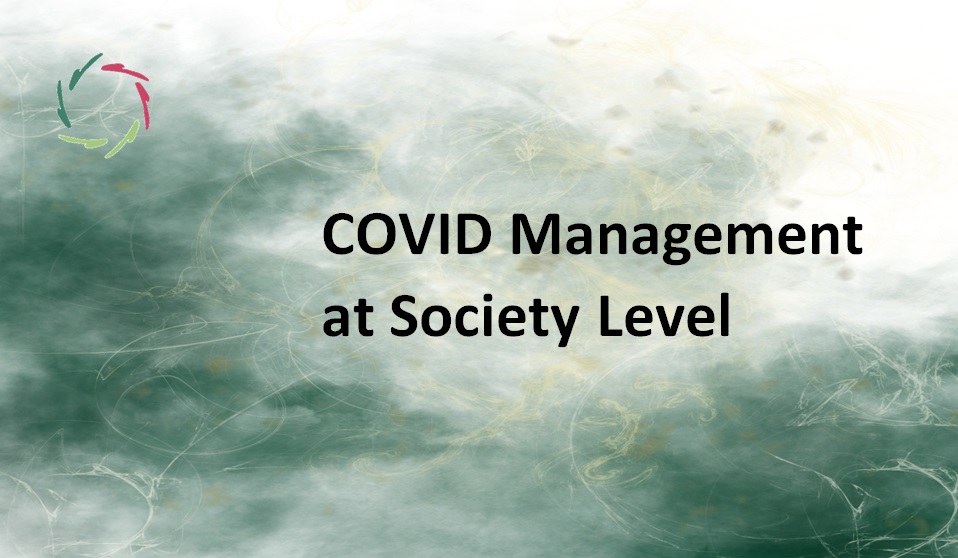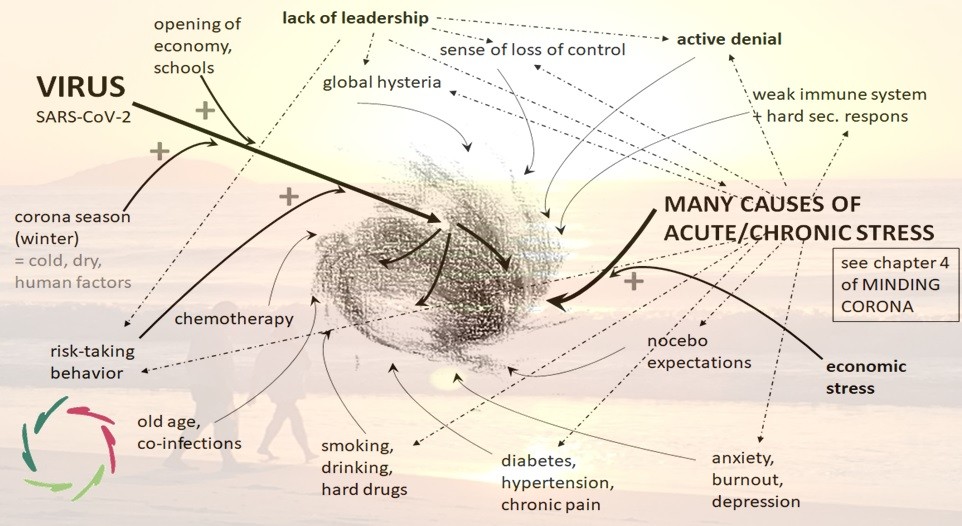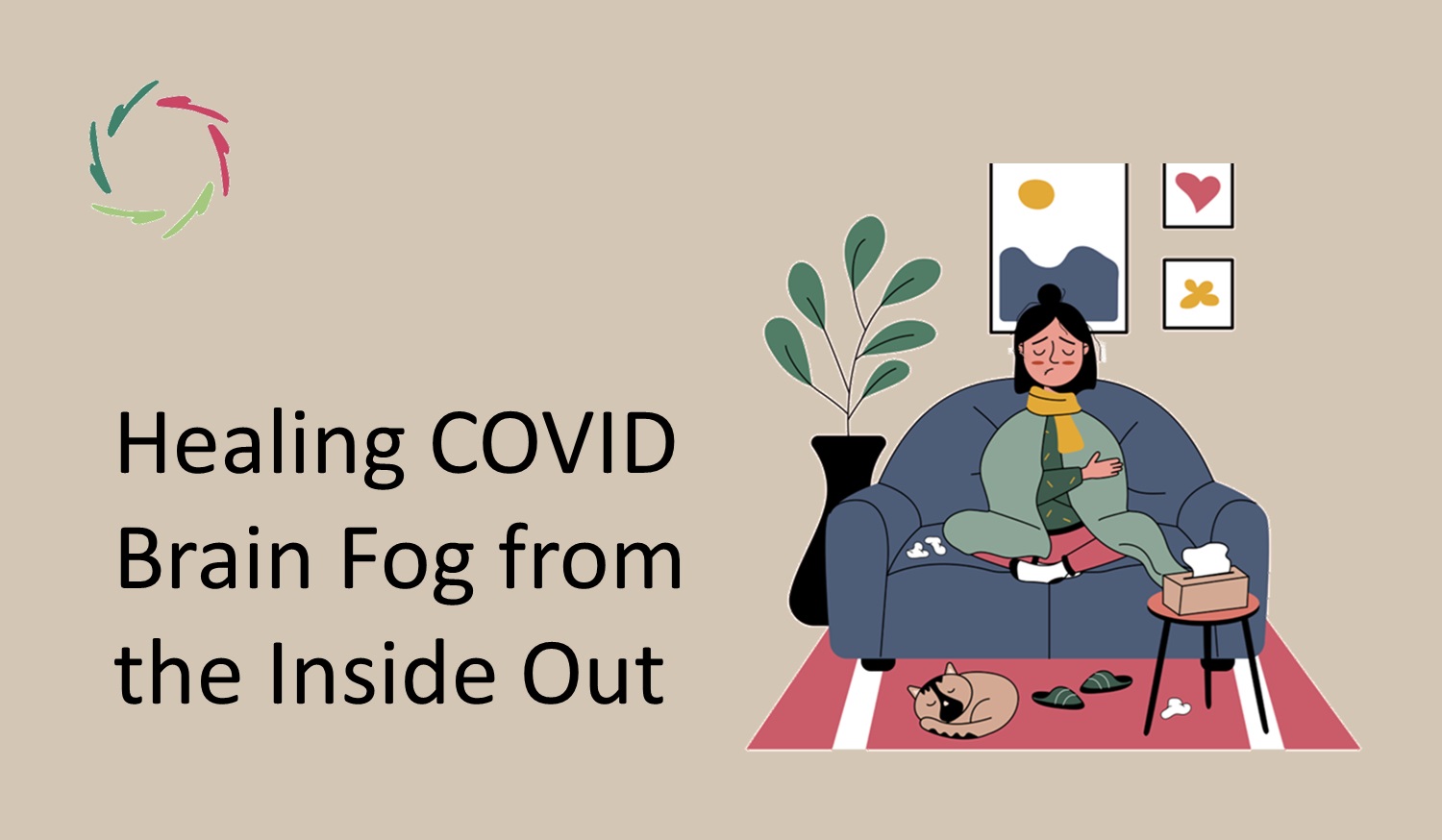31. COVID Management at Society Level – Why, What, How?

I bring together elements discussed in previous blogs/chapters to show that reckoning with the deeper mind and the COVID-whirlpool may lead to specific society-wide (polity) measures that – on top of common-sense hygienic measures – may lessen the pending calamity.
Complexity
Some insight in complexity is advisable. [see: “Complex is not Complicated“]
In the COVID-whirlpool [see: “COVID-Whirlpool“], physical and mental elements reinforce each other and thus can – as a whole – have a much more significant influence than the sum of the elements. Looking at separate components, one cannot grasp the total happening, leading to surprises time and again. This general phenomenon is a characteristic of any complex system. In COVID, it is crucial at the individual and societal level.
On top of this, in the COVID case, many mental elements are subconceptual. This leads to being hardly visible ― amazingly (yes, even now, still, to me) worldwide. I see in the cause of this a confluence of intrapsychic and social factors. Of course, they intermingle, additionally fueling the COVID-whirlpool.
Two causal results of this additional social fuel
Individual and societal:
- For the individual, it is even harder to keep out of the danger zone. In several personal experiences, I see people just let themselves flow towards it. They don’t resist. Drifting on a social stream, it’s stronger than themselves: <Do as thy neighbor.> Probably – and I fear very much for this – increasingly, many people will get into the situation in which they give it up and are even glad to give it up. Thus, many people prefer to live in denial of inconvenient truths: “I’ll see when I get sick. Before that, I don’t want to make my life miserable. I want to live a pretty normal life.” This way, one may think to be in comfortable control, while disaster is nearby, occurring more rapidly and effectively than expected. Leadership is supposed to bring this comfortable control.
- Yet in due time, at the society level, measures fall over measures, going from one ineffective situation to the next, from insupportable lockdown to throwing all open, to communicating the impossibility of a subsequent lockdown until it is the only way to proceed. Meanwhile, in a society with ‘free’ vocalization, a huge cacophony self-perpetuates critiques about every measure from the moment things go wrong.
What to do?
Let’s look at some examples and learn some lessons. Main lesson: It is possible, at the society level, to exert an immense influence upon our COVID future.
Looking at Uruguay
Inhabitants: 3.5 million
Deaths per million until now: 15.
New cases today: 30.
South-America as a continent is faring poorly on COVID. This makes Uruguay (and Paraguay) an interesting case, an island of COVID health despite its having the highest % of aged 65+ of the continent. They had no forced lockdown. This resembles Japan, for instance, where the number of COVID-related deaths is even lower. It is possible, also in a democracy!
The Uruguayan government took early and severe measures: quarantine, closing schools, and big shopping malls, demanding an early use of face masks. They also used innovative technologies: own diagnostic tests and early contact tracing, excellent information of the public through mobile apps, chatbots, and social media.
They used good sensibilization campaigns, brought from an advising committee of scientists in coordination with the private sector. All went with relatively high transparency. A mobile app, ‘Coronavirus UY,’ enables the following of cases. A coronavirus fund transparently allocates the money spent. In general, the government is open in what, why, how things are done. There is even a temporary diminishment of the pay of the president, ministers, and best-paid administrators. This all leads to a high level of social cohesion. Trust in the government made people motivated to follow the guidelines
Looking at Vietnam
Inhabitants: 97,6 million
Deaths per million until now: 0,4.
New cases today: 6.
According to observers, Vietnam has put in place superb public-health communication. From very early on (second week of January), an alert of pending danger went to the public. In February, the government was advocating for social distancing and hand-washing. In April, a fine for social media posts of false information was installed.
These logical steps inspired, from early on, every citizen to do their part: wearing masks, weeks of quarantine, etc.
Vietnam, a relatively poor country, totals less COVID deaths until now than there are every 90 minutes in the US.
Looking at Belgium
Reluctantly, since we are one of the worst performing countries regarding COVID.
Inhabitants: 11,6 million
Deaths per million until now: 897
New cases today: 10.964
This is thought-provoking, at least. The cacophony is massive. Lots of anxiety and worn-out people, including health professionals. Guidelines to the public are chaotically inconsistent and each time overshadowed by critique. Everybody knows everything and nothing, inundating media. I don’t even know – nor do I care – how many governmental health departments we have in this small country with room for one.
There is much empathy, but in its short-sightedness, it adds to the problem. Here is way too much short-sighted empathy and too little Compassion. That is a recipe for troubles in any country of the free world.
Too late in Europe and the US?
A therapeutic roundup: progress has been made mainly in organ support. Corticoids are obvious. Killer-medications have not been developed. A vaccine may bring relief, little and late. This makes it impossible for some countries to break through the bad times and proceed without a renewed lockdown. As before, in a direct way, the West will suffer much more than the East.
For instance, in the US, key coronavirus forecasts predict over 410,000 total deaths by Jan. 1. In case of little compliance with simple measures, this can reach as high as 620,000. [https://www.cnbc.com/2020/09/04/key-coronavirus-forecast-predicts-over-410000-total-us-deaths-by-jan-1.html#close] In fact, there is quite some skepticism about projections extending this far into the future because there are many unknown factors. Reassuring? One such factor is how the virus’s spread may be affected by the changing seasons. The most important factor that can change the outcome of an outbreak is how humans respond. People’s behavior changes over time and is essentially unpredictable.
Projections of deaths worldwide also vary widely, according to compliance to simple measures. [https://covid19.healthdata.org/global?view=total-deaths&tab=trend]:
February 21, 2021, mortality estimates in different circumstances:
| Mandates easing: | 3.496.912 |
| Current projection: | 2.418.545 |
| Universal masks: | 1.800.406 |
We will get out of it in the spring, most probably, somehow,
and then – don’t be surprised – it will happen again as long as the invisible (our deep mind) is not clearly in focus. We’re talking about 2021, 2022, and so on.
What about the economy? What about the human COVID-suffering? What about indirect morbidity and mortality, deaths by famine worldwide? The social and political unrest, and everything involved in that?
The subconceptual is necessary in management at the society level
Between fearmongering and active denial, there is a space of common sense.
Since the virus is with us, the more infected people stay out of the COVID-whirlpool, the better the community will fare in the end, and with a fairly decent economy. Respecting the mind – conceptually and subconceptually – will help us stay out of the whirlpool and attain herd immunity with or without vaccination.
Several chapters are about what this means individually (about the app and so on). Let’s focus now on society and social polity. A country that doesn’t get the subconceptual right is at risk of going down until a miracle vaccine or medication appears.
Therefore, at every level, COVID should be managed with conceptual as well as subconceptual insight. The latter is, among other things, about people’s trust in leadership and each other. If people are thus motivated, much less hard rules and lockdowns are needed.
A basic rule can be as follows:
People – individuals – need to know, “I can handle this.”
‘To know’ is not only objective but also about being deeply convinced. I will repeatedly use the term ‘deep.’ [see also: “Deep Motivation“]
‘This’ is what is meaningful, or, indeed, deeply meaningful.
All else depends on this essential knowing. It can be realized through one’s strength or with proper support from the trusted leadership. One feels confident and also sees others being confident. Thus, each individual is confident that others will do what is needed to get over the challenge. Either they are forced or deeply motivated. In any case, people need to trust each other in doing the right thing.
So, pointing out that a particular subgroup doesn’t follow the rules and that everybody needs to follow these rules to prevent disaster is to be avoided. For example, a well-meaning communication is the following:
“People need to do five simple things. If they do these things, then everything is OK, and we will be fine.”
This is a clear and motivating message that puts people at ease and in control.
Is it?
In a ‘free country,’ it puts guilt on people. Let me rephrase:
“If you don’t do these simple things that any child can do, it will not ‘be fine.’ The disaster that we foresee will be your fault or the fault of those who don’t comply, and you can do nothing about it. We are all trapped like rats in a cage. Surely, ‘they’ are to blame.”
Telling people they should be motivated is not a right way.
Telling someone to be motivated is not motivating. How could it be? To become motivated is not a conscious act. To think it is, is part of our basic cognitive illusion, ubiquitously wrongfully present. [see: “The Basic Cognitive Illusion“]
Telling people that it’s easy to prevent further COVID mishap, “just following some basic rules,” doesn’t instill confidence, especially if people see others not following the rules already for a long time. Contrary to this, solidarity should be enhanced in every possible way, not by saying that it should be done, but by pointing to the why, time and again. The why, well-articulated, invites people to grow to the occasion, time and again. People may need to be invited many times.
People also need to know they are on the same side as their leadership. Most important is not that everybody agrees with the measurements – which would be impossible anyway – but that all share the same end-values. It is about the articulated ‘why.’ You see: People need to know they can handle this. Therefore, of course, it needs to be the right this, the one they recognize to be relevant to them.
For this purpose, regular (daily) communications are a must. This should be seen as part of COVID management itself. People need to see their leader’s efforts. It relieves stress and impacts COVID straight on. COVID is treated by doctors and by leaders.
Isn’t it beautiful, after all?
The war metaphor
may be efficient to unite people, but it has substantial negative sides, especially since ‘the enemy’ is invisible in COVID. Inside an individual’s brain/mind, the pattern of associations around ‘enemy’ may look for a visible alternative. In the end, everybody can be infectious, so everybody can be ‘the enemy.’
The war metaphor can be active because people may have much pent-up energy. This may get a better outlet in ‘fighting’ without the need for war or aggression. People’s fighting for each other unites them in better ways. Without this outlet, it may be challenging to detract the metaphorical thinking about war. It may even be quite stressful. It may give the impression of making yourself and others vulnerable.
This includes the ‘warriors,’ the healthcare workers, especially those who are in a warrior mindset by nature. Many are; many are not. Those who are can act fiercely against any hint of an alternative take.
Healthcare workers need deep respect.
They don’t need white cloths on window sills.
How do they get deep respect? How does anyone get deep respect? White cloth may have this intention. It may also show deep respect, but not necessarily.
If leadership regularly mentions healthcare workers, for instance, when admonishing people to social distancing, that’s already one step further. It brings people together with healthcare workers and each other in deep meaningfulness. Little ads on television can significantly help.
“With THIS, you prevent THIS.”
“On top of their regular job, they care for you. Please care for them.”
If healthcare workers feel deep respect also without the cloths, then the cloths start to really become meaningful.
Valuing life is always motivating in any communication.
Such as:
“We value the life of old people. We also value their quality of life. There are important differences in how old individuals value their life versus its quality. So we want to give them a choice to the degree of what is possible.”
This is a deep communication. If coming from the heart, it is ‘deep to deep.’ There’s something energetic in this. It is charismatic. It is graceful. It is a present of inner beauty.
It is the ultimate this to be handled. It is ultimately meaningful.
What is ‘life’ to you?


